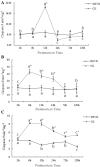Effects of caspase activity of yak meat and internal environment changing during aging
- PMID: 35250061
- PMCID: PMC8882741
- DOI: 10.1007/s13197-021-05145-x
Effects of caspase activity of yak meat and internal environment changing during aging
Abstract
The objective of this study was to investigate the protease family caspases in skeletal muscle and their potential contribution to postmortem proteolysis and meat tenderization. Nine yaks were slaughtered, and samples of Longissimus dorsal were injected with AC-DEVD-CHO at a ratio of 1:1 (w/v) and then stored at 4 °C for 2, 6, 12, 24, 72, and 120 h. Results indicate that the morphological changes of the muscle fibers are significantly obstructed, which is not conducive to the subsequent degradation of proteins. After inhibiting the activity of Caspase- 3, the activity of Caspase-8 and 9 and the energy metabolism was affected. In the case of without inhibition of caspase, the pH value decreased and then increased. The meat color and the water retention are better, the muscle fiber skeleton protein degradation is remarkable, the tenderness is improved. Furthermore, yak meat tenderness was improved by apoptotic pathway during aging.
Keywords: AC-DEVD-CHO; Caspase; Tenderness; Yak.
© Association of Food Scientists & Technologists (India) 2021.
Figures






References
-
- Borges BO, Curi RA, Baldi F, Feitosa FLB, Albuquerque LGD, Oliveira HND, et al. Polymorphisms in candidate genes and their association with carcass traits and meat quality in nellore cattle. Pesq Agrop Brasileira. 2014;49(5):364–371. doi: 10.1590/S0100-204X2014000500006. - DOI
LinkOut - more resources
Full Text Sources
Research Materials
